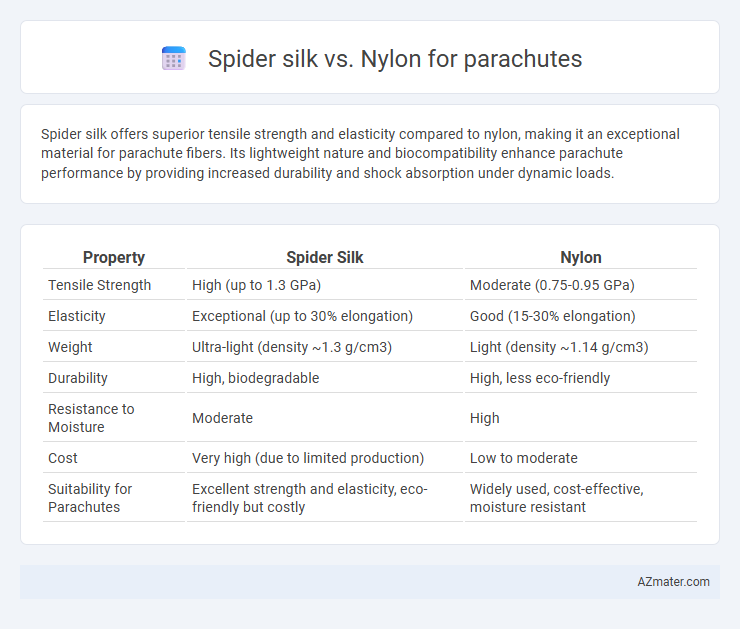Spider silk offers superior tensile strength and elasticity compared to nylon, making it an exceptional material for parachute fibers. Its lightweight nature and biocompatibility enhance parachute performance by providing increased durability and shock absorption under dynamic loads.
Table of Comparison
| Property | Spider Silk | Nylon |
|---|---|---|
| Tensile Strength | High (up to 1.3 GPa) | Moderate (0.75-0.95 GPa) |
| Elasticity | Exceptional (up to 30% elongation) | Good (15-30% elongation) |
| Weight | Ultra-light (density ~1.3 g/cm3) | Light (density ~1.14 g/cm3) |
| Durability | High, biodegradable | High, less eco-friendly |
| Resistance to Moisture | Moderate | High |
| Cost | Very high (due to limited production) | Low to moderate |
| Suitability for Parachutes | Excellent strength and elasticity, eco-friendly but costly | Widely used, cost-effective, moisture resistant |
Introduction: Spider Silk and Nylon as Parachute Materials
Spider silk exhibits remarkable tensile strength and elasticity, making it a highly resilient material for parachute applications due to its lightweight and biodegradability. Nylon, a synthetic polymer extensively used in parachute fabrication, offers durability, water resistance, and long-lasting performance under variable atmospheric conditions. Both materials present unique mechanical properties affecting parachute reliability, durability, and environmental impact in aerospace and recreational uses.
Historical Overview of Parachute Materials
Early parachutes utilized natural fibers such as silk, valued for its exceptional tensile strength and lightweight properties, with spider silk being studied for its superior elasticity and durability compared to traditional silk. Nylon emerged in the 1940s as a revolutionary synthetic alternative, offering increased resistance to moisture, abrasion, and UV degradation, which enhanced parachute reliability and performance during World War II. The transition from natural fibers like spider and silkworm silk to nylon marked a pivotal development in parachute technology, balancing strength, weight, and environmental resistance.
Spider Silk: Biological Structure and Properties
Spider silk exhibits exceptional tensile strength and elasticity due to its unique protein-based fiber structure composed of fibroin molecules arranged in a hierarchical nanostructure. This biomaterial's molecular arrangement provides remarkable toughness, outclassing many synthetic fibers like nylon in terms of strength-to-weight ratio and energy absorption. Its biodegradability and lightweight nature make spider silk an emerging material for advanced parachute fabrication, offering enhanced performance and environmental benefits compared to conventional nylon parachutes.
Nylon: Synthetic Composition and Features
Nylon, a synthetic polymer composed of polyamides, offers exceptional strength, elasticity, and resistance to abrasion, making it a preferred material for parachute fabrication. Its lightweight yet durable fibers provide superior tensile strength and flexibility, ensuring reliable performance under varied stress conditions during deployment. The material's resistance to moisture, UV radiation, and chemicals enhances longevity and safety in parachute applications compared to natural fibers like spider silk.
Strength and Durability Comparison
Spider silk exhibits remarkable tensile strength, often surpassing nylon, making it an exceptional material for parachute applications requiring high load tolerance. Its natural protein structure provides superior elasticity and resistance to fatigue, enhancing durability under repeated stress. Nylon, while strong and widely used in parachutes, tends to degrade more quickly under UV exposure and abrasion compared to spider silk's robust and self-healing properties.
Flexibility and Elasticity Analysis
Spider silk exhibits superior flexibility and elasticity compared to nylon, making it an excellent material for parachute applications that require dynamic stretch and recovery. Its remarkable tensile strength combined with a high degree of elasticity allows spider silk to absorb and dissipate energy efficiently during parachute deployment. Nylon, while durable and flexible, typically has lower elasticity, resulting in less energy absorption and a stiffer material response under sudden stress.
Weight and Portability Considerations
Spider silk offers exceptional strength-to-weight ratio, making it significantly lighter than nylon for parachute applications. Its ultra-lightweight fibers enhance portability by reducing overall gear weight, beneficial for long-duration or high-altitude jumps. Nylon, while durable, tends to be heavier and bulkier, which can increase packing size and limit ease of transport.
Environmental Impact and Sustainability
Spider silk outperforms nylon in environmental impact due to its biodegradability and renewable production process, making it a more sustainable material for parachute manufacturing. Nylon, derived from petrochemicals, contributes to pollution and exhibits slower decomposition, increasing environmental burden. The shift towards spider silk can significantly reduce carbon footprint and waste, supporting eco-friendly parachute solutions.
Cost and Production Scalability
Spider silk offers exceptional strength-to-weight ratio and biodegradability but remains cost-prohibitive due to complex synthesis and limited production scalability. Nylon, widely used in parachute manufacturing, provides affordable mass production with established industrial processes and consistent material properties. The high scalability and lower expenses of nylon make it the practical choice over spider silk for commercial parachute applications.
Future Prospects: Advancements and Applications
Spider silk offers superior tensile strength and elasticity compared to nylon, making it a promising material for next-generation parachutes with enhanced durability and impact resistance. Advances in bioengineering techniques are enabling scalable production of recombinant spider silk, potentially reducing costs and environmental impact compared to synthetic nylon fibers. Emerging applications include ultra-lightweight, biodegradable parachute fabrics that improve performance and safety in aerospace and military operations.

Infographic: Spider silk vs Nylon for Parachute
 azmater.com
azmater.com